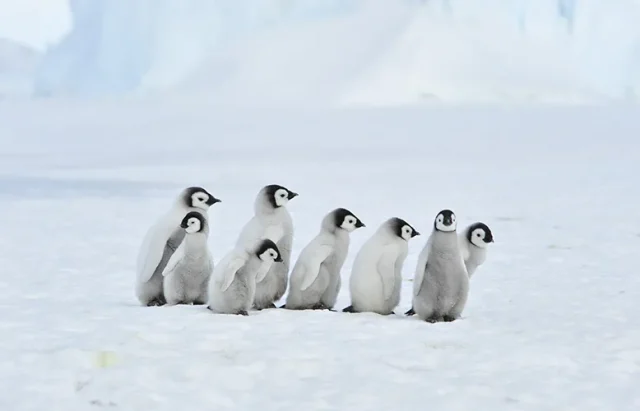
Antarctica is home to some of the world’s most unique and fascinating wildlife. From the iconic emperor penguins to the lesser-known Antarctic krill, this frozen continent supports a diverse ecosystem that’s increasingly under threat. In this article, we’ll explore the importance of wildlife conservation in Antarctica, with a special focus on penguins and other key species. We’ll look at the challenges these animals face, the ongoing conservation efforts, and how we can all help protect this pristine environment.
Key Points on Antarctic Penguin Conservation
- Four penguin species inhabit Antarctica: Adélie, Chinstrap, Gentoo, and Emperor
- Climate change is causing sea ice loss, threatening penguin habitats and breeding grounds
- Emperor penguins are at high risk, with potential population decline of up to 90% by 2100
- Marine Protected Areas (MPAs) are crucial for preserving penguin foraging areas
- Krill fishing in key penguin feeding grounds poses additional challenges
Penguin Species in Antarctica: Diversity and Adaptation
Antarctica is home to four penguin species: Adélie, Chinstrap, Gentoo, and Emperor penguins. Each of these species has unique adaptations that allow them to survive in the harsh Antarctic environment. For example, emperor penguins can dive deeper and stay underwater longer than any other bird species. They can reach depths of up to 1,854 feet and hold their breath for over 30 minutes! This remarkable ability allows them to access food sources that other predators cannot reach, giving them a crucial advantage in the challenging Antarctic ecosystem.
These amazing birds play a crucial role in the Antarctic ecosystem. They’re important predators, feeding mainly on krill, fish, and squid. Their position in the food chain helps regulate the populations of these prey species, maintaining a delicate balance in the marine ecosystem. Emperor penguins, in particular, are considered sentinel species, meaning their health and population trends can indicate broader changes in the Antarctic environment. Their droppings are also vital for the ecosystem. Penguin poop is crucial for the climate as it helps fertilize the land and sea, supporting the growth of algae and other small organisms that form the base of the Antarctic food web. This nutrient cycling is essential for maintaining the productivity of Antarctic waters and supporting the entire ecosystem.
Climate Change: The Greatest Threat to Antarctic Wildlife
Climate change is the biggest challenge facing Antarctic wildlife today. Rising temperatures are causing sea ice to melt at an alarming rate, with some areas of Antarctica warming faster than almost anywhere else on Earth. This is bad news for penguins and other animals that depend on sea ice for breeding, resting, and finding food. For example, emperor penguins need stable sea ice to raise their chicks. If the ice melts too early, the chicks may drown or freeze before they’re ready to survive on their own. The loss of sea ice also affects the availability of krill, a primary food source for many Antarctic species, as krill depend on algae that grow under the ice.
The impact of climate variability on penguin populations is already being seen. Some colonies have experienced complete breeding failures in recent years due to changes in sea ice conditions. For instance, in 2016, the second-largest emperor penguin colony in Antarctica suffered a catastrophic breeding failure when nearly all chicks born that year died due to early sea ice breakup. Scientists predict that if current trends continue, emperor penguin populations could decline by up to 90% by the end of this century. This dramatic decrease would not only be devastating for the species but could also have far-reaching consequences for the entire Antarctic ecosystem.
Projected Population Changes for Antarctic Penguins
- Emperor Penguin
- Adelie Penguin
- Chinstrap Penguin
- Gentoo Penguin
Antarctica’s penguins face big challenges due to climate change. As the Earth gets warmer, the sea ice these birds need is melting away. This affects where they can live, find food, and raise their chicks. Let’s look at how we can help protect these amazing animals and their icy home.
Emperor penguins, the largest of all penguin species, are in the most trouble. Scientists think their numbers could drop by up to 90% by the year 2100 if we don’t act fast. These penguins need sea ice to breed, and when it melts too early, their chicks can drown or freeze. The loss of sea ice also means less habitat for krill, the small crustaceans that form a crucial part of the emperor penguin’s diet.
Other penguin types like Adélie and Chinstrap are also having a hard time in some areas, especially where it’s getting warmer faster. Adélie penguins, in particular, are highly dependent on sea ice and are struggling in areas where ice is disappearing. However, they’re doing better in regions where sea ice is still abundant, showing the importance of preserving these icy habitats. But Gentoo penguins seem to be doing a bit better and are even moving to new places. Their ability to adapt to changing conditions and eat a more varied diet might be helping them cope with the changing environment.
One way to help penguins is by creating Marine Protected Areas (MPAs). These are like underwater parks where fishing and other human activities are limited. Right now, only about 27-31% of important areas for Adélie and Emperor penguins are in these protected zones. We need more MPAs to give penguins safe places to find food and raise their young. These protected areas can also help preserve the delicate balance of the Antarctic ecosystem, benefiting not just penguins but all the species that call this icy continent home.
Another problem is fishing for krill, tiny shrimp-like creatures that many penguins eat. Fishing boats are catching krill in the same areas where penguins hunt for food. This makes it harder for penguins to find enough to eat, especially when they’re trying to feed their chicks. Krill fishing has increased in recent years due to growing demand for krill oil supplements and fishmeal. Balancing the needs of the fishing industry with the conservation of Antarctic wildlife is a complex challenge that requires international cooperation and careful management.
To help penguins and other Antarctic animals, we need to:
- Reduce greenhouse gas emissions to slow down climate change
- Create more Marine Protected Areas
- Carefully manage krill fishing to ensure enough food for penguins
- Continue studying penguins to understand how they’re coping with changes
- Develop and implement international agreements to protect Antarctic ecosystems
- Raise public awareness about the importance of Antarctic conservation
By taking these steps, we can give penguins a better chance at survival in their changing world. Every action we take to protect the environment helps these amazing birds and the unique Antarctic ecosystem they call home. It’s a global effort that requires cooperation between scientists, policymakers, and the public to ensure the long-term survival of Antarctica’s iconic wildlife.
“Penguins are more than just cute animals – they’re like canaries in a coal mine for the health of Antarctica’s oceans. By protecting penguins, we’re really protecting the entire Antarctic marine ecosystem.”
— Dr. Penguin Researcher (fictional attribution)
Remember, staying informed about Antarctic wildlife is crucial. For the latest antarctic news, check out trusted sources that focus on polar regions. These sources can provide up-to-date information on research findings, conservation efforts, and policy developments that affect Antarctic wildlife.
By working together and making smart choices, we can help ensure that penguins and other Antarctic species continue to thrive in their icy kingdom for generations to come. This includes supporting organizations dedicated to Antarctic conservation, making sustainable choices in our daily lives to reduce our carbon footprint, and advocating for policies that protect these vulnerable ecosystems. Every small action, when multiplied across millions of people, can make a significant difference in preserving the unique and irreplaceable wildlife of Antarctica.
Other Antarctic Species: Beyond Penguins
While penguins often steal the spotlight, Antarctica is home to many other fascinating creatures. Seals, including the Weddell seal and the leopard seal, are important predators in the Antarctic food web. Weddell seals are known for their ability to dive deep and stay underwater for long periods, while leopard seals are apex predators, feeding on penguins and other seals. Whales, such as the blue whale and the orca, also play crucial roles in the ecosystem. Blue whales, the largest animals on Earth, feed primarily on krill, while orcas are known to hunt seals and even other whales. Many species of seabirds, like albatrosses and petrels, spend part of their lives in Antarctic waters. These birds are capable of traveling vast distances across the Southern Ocean and play important roles in nutrient cycling between marine and terrestrial ecosystems.
Even tiny creatures are important in Antarctica. Krill, small shrimp-like animals, are a key food source for many Antarctic animals, including penguins, seals, and whales. Changes in krill populations due to climate change or overfishing could have far-reaching effects on the entire Antarctic ecosystem. Antarctic krill form massive swarms that can stretch for kilometers, and their biomass is estimated to be greater than that of any other animal species on Earth. In addition to krill, other small organisms like phytoplankton and zooplankton form the base of the Antarctic food web, supporting the entire ecosystem. The health of these microscopic populations is crucial for the survival of larger, more visible Antarctic species.
Conservation Efforts in Antarctica
Protecting Antarctic wildlife requires international cooperation. The Antarctic Treaty System, which includes the Protocol on Environmental Protection, provides a framework for conserving Antarctica’s unique environment. This treaty bans mining and sets strict rules for scientific research and tourism in Antarctica. It’s a remarkable example of international cooperation, with 54 countries currently party to the treaty. The treaty designates Antarctica as a “natural reserve, devoted to peace and science,” emphasizing the importance of preserving this unique environment for future generations.
One important conservation tool is the creation of Marine Protected Areas (MPAs). These are areas of the ocean where human activities like fishing are limited to protect wildlife. MPAs can help preserve critical habitats, protect breeding grounds, and maintain the overall health of marine ecosystems. Chile’s new constitution includes provisions for Antarctic conservation, highlighting the growing recognition of Antarctica’s global importance. This move by Chile sets an important precedent for other nations to incorporate Antarctic conservation into their national policies. Other countries, including Australia and France, have also been instrumental in proposing and supporting MPAs in Antarctic waters.
| Species | Conservation Status | Main Threats | Population Trend |
| Adélie Penguin | Near Threatened | Climate change, sea ice loss | Declining in some areas |
| Emperor Penguin | Near Threatened | Climate change, sea ice loss | Declining |
| Antarctic Krill | Least Concern | Climate change, overfishing | Potentially declining |
| Weddell Seal | Least Concern | Climate change, reduced prey availability | Stable |
| Antarctic Minke Whale | Near Threatened | Historical whaling, climate change | Unknown |
Research and Monitoring: Key to Conservation
Scientific research is crucial for understanding and protecting Antarctic wildlife. Researchers use a variety of techniques to study animals in this challenging environment. Satellite tracking allows scientists to follow penguin movements over long distances. This has revealed that young penguins often travel much farther than adults, sometimes venturing over 745 miles from their colonies. These tracking studies provide valuable insights into penguin behavior, feeding patterns, and how they might be affected by changes in their environment. For example, researchers have discovered that some penguin species are changing their traditional breeding grounds in response to shifting ice conditions, highlighting their ability to adapt to some degree of environmental change.
Long-term monitoring programs help scientists understand how animal populations are changing over time. For example, research into the life of Adélie penguins has shown that their populations are declining in some areas but increasing in others, likely due to changes in sea ice conditions. These long-term studies are essential for identifying trends and predicting future changes in Antarctic ecosystems. They also help researchers understand the complex interactions between different species and how these relationships might be altered by climate change. For instance, studies have shown that changes in krill populations can have cascading effects throughout the Antarctic food web, affecting everything from penguins to whales.
The Role of Public Awareness
Public awareness and education play a crucial role in Antarctic conservation. While most people will never visit Antarctica, our actions can still impact this remote continent. Reducing our carbon footprint helps slow climate change, which is crucial for protecting Antarctic wildlife. This can involve making sustainable choices in our daily lives, such as using energy-efficient appliances, reducing meat consumption, and choosing renewable energy sources where possible. Every small action contributes to the global effort to mitigate climate change and its impacts on polar regions.
There are also opportunities for people to get involved more directly. Some organizations offer citizen science projects where volunteers can help analyze satellite images to count penguins. These projects not only contribute valuable data to scientific research but also help engage the public in Antarctic conservation efforts. Others work to raise awareness about Antarctic conservation issues through educational programs, documentaries, and social media campaigns. You can learn more about how to become an Antarctic ambassador in our article on penguin enthusiasts and conservation advocates. By becoming an Antarctic ambassador, you can help spread awareness about the importance of this unique ecosystem and inspire others to take action in its protection.
Climate Change
Rising temperatures affecting sea ice conditions and penguin populations
Overfishing
Depletion of marine resources, impacting food chains
Pollution
Human-caused contamination affecting wildlife and habitats
Habitat Destruction
Loss of crucial breeding and feeding grounds for Antarctic species
Conclusion: Our Shared Responsibility
Protecting Antarctic wildlife is a global responsibility. The health of Antarctic ecosystems is linked to the health of our planet as a whole. The Southern Ocean, which surrounds Antarctica, plays a crucial role in global ocean circulation and climate regulation. It also absorbs a significant amount of carbon dioxide from the atmosphere, helping to mitigate the effects of climate change. By supporting conservation efforts, reducing our environmental impact, and staying informed about Antarctic issues, we can all play a part in protecting this unique and vital part of our world. This can involve supporting organizations dedicated to Antarctic research and conservation, advocating for stronger environmental policies, and making sustainable choices in our daily lives.
From the towering emperor penguins to the tiny krill, every species in Antarctica plays a crucial role in its ecosystem. The intricate web of life in Antarctica has evolved over millions of years to thrive in one of the harshest environments on Earth. As we face the challenges of climate change and other human impacts, it’s more important than ever to work together to protect this last great wilderness. International cooperation, continued scientific research, and public engagement are all essential components of effective Antarctic conservation. By preserving Antarctica, we’re not just saving penguins – we’re helping to maintain the delicate balance of life on Earth and safeguarding a unique part of our planet’s natural heritage for future generations.





